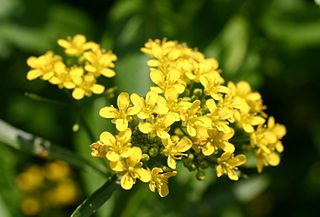
Rorippa is a genus of flowering plants in the family Brassicaceae, native to Europe through central Asia, Africa, and North America. Rorippa species are annual to perennial herbs, usually with yellow flowers and a peppery flavour. They are known commonly as yellowcresses.

Jeholornis is a genus of avialan dinosaurs that lived between approximately 122 and 120 million years ago during the early Cretaceous Period in China. Fossil Jeholornis were first discovered in the Jiufotang Formation in Hebei Province, China and additional specimens have been found in the older Yixian Formation.

Campsicnemus is a genus of flies in family Dolichopodidae. There are more than 290 described species, made up of 34 Palearctic, 22 Nearctic, seven Afrotropic, 170 Australasian and Oceanian, and seven Indomalayan species. Some species endemic to the Hawaiian islands are characterized by their lack of wings. After the introduction of invasive ants and other alien species such as wild boar (Sus scrofa) to the islands, some of these flightless species are believed extinct.

Clivina is a genus of ground beetle native to the Palearctic, the Nearctic, the Near East and North Africa. There are more than 600 described species in Clivina.

Pycnanthemum is a genus of herbaceous plants in the mint family (Lamiaceae). Species in this genus are often referred to as "mountain mints" and they often have a minty or thyme-like aroma when crushed. All species of Pycnanthemum are native to the United States and Canada. The center of diversity for the genus is North Carolina with 13 of the 20 species having been collected therein. Nineteen of the 20 species of Pycnanthemum occur in the Eastern US and Canada, and one disjunct species occurs in California and Oregon.

Phacelia curvipes is a species of flowering plant in the borage family, Boraginaceae, known by the common names Washoe phacelia and Washoe scorpionweed. It is native to the southwestern United States, where it grows in many types of habitat, such as chaparral, oak and pine woodland, and forests.
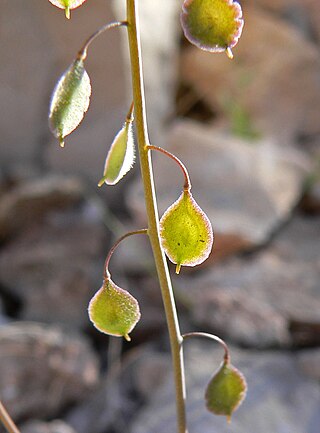
Thysanocarpus curvipes is a species of flowering plant in the family Brassicaceae known by the common names sand fringepod and lacepod. It is native to western North America from British Columbia through the western United States to Baja California, where it grows in many types of habitat. It is a common plant in much of its range. It is variable in appearance. It is an annual herb producing a branching or unbranched stem 10 to 80 centimeters tall. The leaves are mostly lance-shaped but variable. The lower ones are sometimes borne on petioles and the upper ones may clasp the stem at their bases. They may be smooth-edged, toothed, or lobed. The inflorescence is a raceme of flowers with four white or purple-tinged petals and purple sepals. The fruit is a flattened, rounded or oval disclike capsule with a thin wing around the edge. The fruit is under a centimeter long and the wing is variable in appearance, flat or wavy, sometimes perforated.
Anoncopeucus is a small genus of beetles first named in 1871 by Russian entomologist Maximilien Chaudoir. Anoncopeucus is part of the tribe Orthogoninii, a small group of ground beetles native to subtropical Asia and North Africa. Species in the genus Anoncopeucus occur in Thailand, Indonesia, and Borneo.
Moriomorpha is a genus in the beetle family Carabidae. There are about six described species in Moriomorpha, found in Australia.
Sphaerocerinae is a subfamily of flies belonging to the family Sphaeroceridae.

Sphaerocera is a genus of flies belonging to the family of the lesser dung flies.

Lesteva is a genus of ocellate rove beetles in the family Staphylinidae. There are at least 60 described species in Lesteva.

Mesostenus is a genus of ichneumon wasps in the family Ichneumonidae. There are at least 50 described species in Mesostenus.

Scelolyperus is a genus of skeletonizing leaf beetles in the family Chrysomelidae. There are more than 20 described species in Scelolyperus. They are found in North America, Mexico, and the Palaearctic.

Ophyiulus is a genus of millipedes in the family Julidae. There are more than 30 described species in Ophyiulus.
Epimechus curvipes is a species of true weevil in the beetle family Curculionidae. It is found in North America.
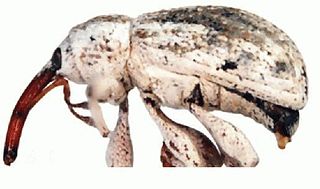
Epimechus is a genus of true weevils in the beetle family Curculionidae. There are more than 20 described species in Epimechus.

Kiekie is a genus of wandering spiders first described by D. Polotow and Antônio Domingos Brescovit in 2018. The type species, Kiekie sinuatipes, was originally described under the name "Ctenus sinuatipes".
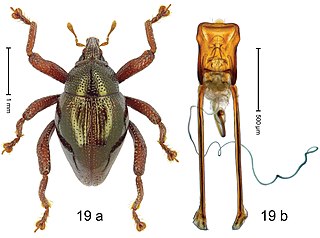
Trigonopterus curvipes is a species of flightless weevil in the genus Trigonopterus from Indonesia.
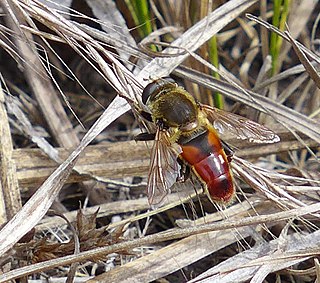
Polydontomyia is a genus of rat-tail maggot flies in the family Syrphidae. The genus is monotypic, comprising a single species, Polydontomyia curvipes, also known as the dimorphic sickleleg. It was formerly a member of the genus Lejops.

















